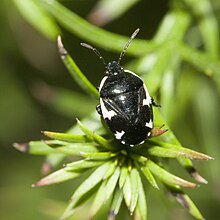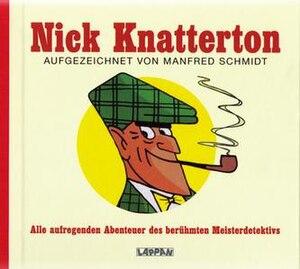Condylognatha
Condylognatha| Condylognatha 시간 범위:석탄기 period–홀로세, 350–0 엄마 PreꞒ Ꞓ OSDCPTJKPg N[1]. | |
|---|---|
 | |
| 반시류에서부터 Tritomegas sexmaculatus. | |
| 과학적 분류 | |
| 킹덤: | 동물계 |
| Phylum: | 절지 동물문 |
| 클래스: | 살충제 |
| (랭킹되지 않음): | 파라네오프테라속 |
| Superorder: | Condylognatha |
| 주문 | |
| |
는 노린재목(진정한 벌레)과 총채 벌레목(삽주 벌레)가 들어 있Condylognatha은 단 계통 그룹(상목)[2].Condylognatha Paraneoptera가 자매 그룹 포함하면 lice(Psocodea)에 속해 있다.[3][4]
분류학
반시류와 총채 벌레목는 양쪽 sister-groups 형태적 문자를 기반으로 공동으로 Condylognatha으로 알려져 있다.[5]
반시류
곤충들 대부분은 종종 진정한 벌레(비교하라. 도청하다)로 알려진 반시류 /hɛˈmɪptərə/은 명령, 매미, 진딧물, planthoppers, leafhoppers, 방패 벌레, 침대 벌레와 다른 사람들의 약 50,000–80,000 종을 말한다.그것들은 크기가 1밀리 미터(0.039에)15센티미터에(5.9에)에서와 구기는 빠는 거는 일반적인 배열을 공유하기까지 다양하다.
총채 벌레목
주문 총채 벌레목 5,500종 두 suborders은 산란관에 의해 두드러지로 구분 포함한다.반면 Tubulifera지 않는다 Terebrantia, 잘 발달된 원뿔형 산란관을 가지고 있다.대신 복부는 튜브의 모양에 그려져 있다.이 곤충들은 삽주 벌레라고 불린다.
필로제니
| Condylognatha |
| ||||||||||||||||||||||||||||||
참조
- ^ Truman, James W.; Riddiford, Lynn M. (2019). "The evolution of insect metamorphosis: A developmental and endocrine view". Philosophical Transactions of the Royal Society B: Biological Sciences. 374 (1783). doi:10.1098/rstb.2019.0070. PMC 6711285. PMID 31438820.
- ^ Grimaldi, David; Engel, Michael S.; Engel, Michael S.; Engel, Senior Curator and Professor Michael S. (May 16, 2005). Evolution of the Insects. Cambridge University Press. ISBN 9780521821490 – via Google Books.
- ^ Johnson, Kevin P.; Dietrich, Christopher H.; Friedrich, Frank; Beutel, Rolf G.; Wipfler, Benjamin; Peters, Ralph S.; Allen, Julie M.; Petersen, Malte; Donath, Alexander; Walden, Kimberly K. O.; Kozlov, Alexey M.; Podsiadlowski, Lars; Mayer, Christoph; Meusemann, Karen; Vasilikopoulos, Alexandros; Waterhouse, Robert M.; Cameron, Stephen L.; Weirauch, Christiane; Swanson, Daniel R.; Percy, Diana M.; Hardy, Nate B.; Terry, Irene; Liu, Shanlin; Zhou, Xin; Misof, Bernhard; Robertson, Hugh M.; Yoshizawa, Kazunori (December 11, 2018). "Phylogenomics and the evolution of hemipteroid insects". Proceedings of the National Academy of Sciences. 115 (50): 12775–12780. doi:10.1073/pnas.1815820115. PMC 6294958. PMID 30478043.
- ^ Johnson, Kevin P.; Dietrich, Christopher H.; Friedrich, Frank; Beutel, Rolf G.; Wipfler, Benjamin; Peters, Ralph S.; Allen, Julie M.; Petersen, Malte; Donath, Alexander; Walden, Kimberly K. O.; Kozlov, Alexey M.; Podsiadlowski, Lars; Mayer, Christoph; Meusemann, Karen; Vasilikopoulos, Alexandros; Waterhouse, Robert M.; Cameron, Stephen L.; Weirauch, Christiane; Swanson, Daniel R.; Percy, Diana M.; Hardy, Nate B.; Terry, Irene; Liu, Shanlin; Zhou, Xin; Misof, Bernhard; Robertson, Hugh M.; Yoshizawa, Kazunori (December 11, 2018). "Phylogenomics and the evolution of hemipteroid insects". Proceedings of the National Academy of Sciences of the United States of America. 115 (50): 12775–12780. doi:10.1073/pnas.1815820115. PMC 6294958. PMID 30478043.
- ^ Li, Hu; Shao, Renfu; Song, Nan; Song, Fan; Jiang, Pei; Li, Zhihong; Cai, Wanzhi (February 23, 2015). "Higher-level phylogeny of paraneopteran insects inferred from mitochondrial genome sequences". Scientific Reports. 5 (1): 8527. Bibcode:2015NatSR...5E8527L. doi:10.1038/srep08527. PMC 4336943. PMID 25704094.


